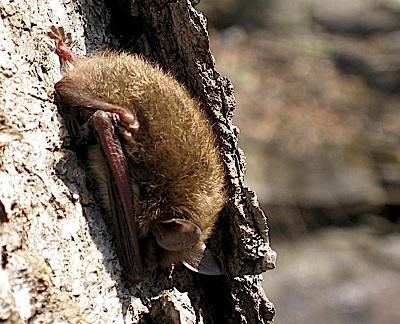Yet another unit of the National Park System has detected white-nose syndrome in its bat populations.
Officials at New River Gorge National River announced Monday that the deadly disease has been confirmed by the Southeast Cooperative Wildlife Disease Study lab. A bat suspected of having the disease was captured after a Park Service biologist noticed bats coming out of some of the abandoned mine portals that dot the national river.
"It was the wrong time of year and definitely the wrong time of day for healthy bats to be coming out of the mines, rather than hibernating," said Mark Graham.
The West Virginia Department of Natural Resources had discovered WNS in bats last winter in the counties just east of the park and elsewhere in the state.
White-nose syndrome is a disease caused by the fungus Geomyces destructans and is responsible for the deaths of more than 1 million bats in eastern North America. First discovered in a New York cave in February 2006, the fungus has spread rapidly – having been detected west into Oklahoma, north into Canada, and south to North Carolina.
The fungus thrives in cold and humid conditions typical of those found in caves and mines in which many bat species hibernate. The disease got its name from the white fungal growth which can be seen around the muzzles, ears, and wing membranes of affected bats, typically during their hibernation.
Just last week officials reported that the disease had been confirmed in Kentucky about 180 miles west of Mammoth Cave National Park. While that park has not yet detected presence of the disease in any of its bat colonies, it has been found in colonies at Great Smoky Mountains National Park, Delaware Water Gap National Recreation Area, and Ozark National Scenic Riverways.
At New River, of the ten species of bats occurring in the park, seven are considered “cave hibernating” bat species and three are tree bat species. Six of the park’s cave species have proven to be susceptible to WNS elsewhere in the nation, including the federally endangered Indiana bat, park officials said in a release.
Bats with WNS appear to use up their precious fat reserves too quickly to stay in hibernation through the winter. The fungus is transmitted from bat to bat, but long distance, sudden leaps of the fungus are believed to have been facilitated by human activities, the Park Service said.
To date there are no known cures for the disease, which does not seem to affect humans or other animals. Scientists are cautious about applying any fungicide treatments in caves or mines as that could risk disrupting delicate subterranean ecosystems, the Park Service said.
Before WNS, bats have been long-lived small mammals with average life spans of about 20 years; some little brown bats have been documented to live over 40 years. Though long-lived, bats reproduce slowly with each mother having only one pup per year, the Park Service said, adding that "If bat populations ever recover to pre-WNS levels, it will take a long time."
New River officials are asking anyone who sees what look to be dead or sick bats within the national river boundaries to report them to park headquarters at 304-465-0508.




Comments
This news makes me very sad. I wish someone would figure out a way to stop this fungus.